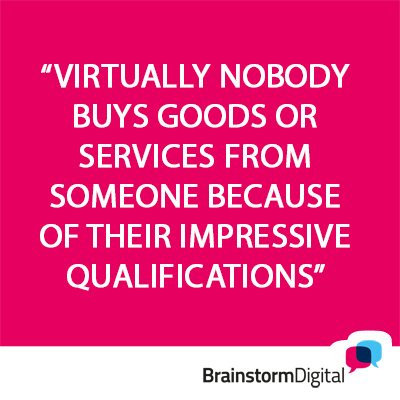Imagine you had an appointment with a great new lead. This is a hot prospect, and you’re hoping to come away with a big fat contract.
You turn up for the presentation, open PowerPoint, and….. Start to walk them through every job you’ve ever held.
You throw in a few key-skill clichés along the way – “Strong team player, good at motivating others…” – and the grand finale is a list of your A-Level results from 1981.
You’d get laughed out of the building, right?
And yet that is exactly the approach taken by the huge majority of people on LinkedIn, even those hoping that the networking site will be a great way to drum up new business.
They treat their profiles like an extended CV – and are then disappointed when no one bites.
It is true that LinkedIn can be a hugely powerful generator of leads. But the first step is to make sure your profile is attractive to the right people. It will always be the first thing any potential prospect looks at.
That means making two changes in mentality.
First, you need to focus on the future – not on the past.
When you look for a job, your LinkedIn profile will inevitably look backwards, towards your career history. That’s what people talk about when they’re looking for a job….
But when you are writing your profile in order to attract prospects, that is irrelevant. You need to focus on the future – on what you have to offer new clients, the difference you are going to make to their companies and the opportunities inherent in working together.
You need to write directly to your ideal client, the type of company who would most benefit from the solution you’re offering. Think carefully: What do they need to hear from you, in order to become convinced that you are someone they must connect with?
I can assure you that the answer does not include your first job out of university, or successfully managing your team in your last position.
Secondly – and directly connected to that – you have to keep in mind that you’re not really promoting yourself. You’re promoting what you and your business can do for prospective clients.
Of course, that’s partly about you personally, especially if you own the business. But remember: virtually nobody buys goods or services from someone because of their impressive qualifications. They want to know how you can help them.
This means that you’ll be writing mostly about your company – not about yourself – even on your personal profile.
This can be difficult to get your head round, especially because the way a LinkedIn profile is structured pushes people to treat it as an online CV. But you must get a little creative here, and working within LinkedIn’s strictures, get across what you need to generate new business.
In my next blog I’ll show you how to apply these concepts to your professional headline – the line directly under your name.
But in the meanwhile, take a fresh look at your profile. Does it read like you’re looking for a new job – or new clients? If you are a business owner and it’s the former, it’s time for a radical rethink.








